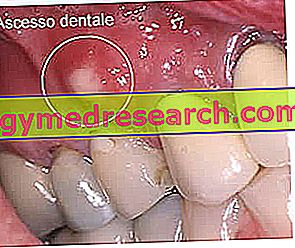Dental abscess: key points
The dental abscess is an accumulation of bacteria, white blood cells, plasma and cellular debris (pus) confined to the tissues surrounding a tooth (gum, mandibular bone or tooth pulp).
Main classification
- Periodontal dental abscess: caused by an infection affecting the tooth supporting apparatus (gingiva, alveolar bone and ligaments)
- Periapical dental abscess: due to an infection of the dental pulp

Causes
The dental abscess is the immediate consequence of complicated caries or serious injuries, which cause purulent infection (rich in pus) of teeth or gums. Among the risk factors, we mention: mal-successful operations on the teeth, poor oral hygiene, diabetes, gastroesophageal reflux disease, AIDS, dry mouth, smoking, alcoholism, long-term therapy with corticosteroids.
Symptoms
Apart from the main symptom of the dental abscess (fierce and relentless toothache), the patient often accuses swollen gums, halitosis, dentinal hypersensitivity, fever and swollen lymph nodes in the neck.
Diagnosis
The diagnosis of dental abscess is rather simple: it uses the anamnestic examination (collection of symptoms reported by the patient) and the physical one (the doctor touches the tooth to test the extent of pain), supported by the aspiration and analysis of a pus sample and tooth radiography to assess the damage.
therapies
Being an infection, the dental abscess requires an antibiotic cure, possibly supported by the administration of painkillers to mask the pain. Pus drainage is also essential for healing.
Definition
The dental abscess is an accumulation of pus enclosed in the tissues surrounding the root of a tooth (gum, mandibular bone or dental pulp). Usually, the dental abscess is caused by bacterial infections that propagate in the dental tissues as a result of complicated caries, chipped / broken teeth or periodontal disease (gum disease).
Classification
Based on the precise location in which it originates, the dental abscess is distinguished into:
- Periodontal abscess : is caused by an infection of the periodontium, the tooth supporting apparatus consisting of gingiva, supporting alveolar bone, radicular cement and ligaments (elastic connecting fibers). Typical of patients suffering from periodontitis (or pyorrhea, if you prefer) and sensitive to gum disease, periodontal dental abscess can also be caused by a purulent infection inside a periodontal pocket.
- Periapical abscess (or complicated pulpitis): the infection originates in the pulp of the tooth as a consequence of seriously complicated caries. Let us remember briefly that the pulp is the vital part of the tooth, rich in arterioles, veins, nerves and osteoblasts (cells used for the production of dentin). Damaging and crumbling the tooth enamel, caries affects dentin until it reaches the dental pulp. In this case, in the case of non-cure, the bacteria involved in the cariogenic process spread in depth causing an extensive purulent infection (rich in pus), which is called periapical dental abscess. The same periapical abscess may also result in severe tooth injuries (eg falls or accidents), such as to induce the dental pulp to necrosis (tooth death).
- Gingival abscess : probably, the least complicated form of the dental abscess that develops directly in the gingiva due to infectious processes. Gingival abscess can be a consequence of a periapical dental abscess.

In general...
Caries / tooth rupture / periodontitis → Infection of tooth pulp or gingiva → progression of the infectious-purulent process in the maxillary bone → dental abscess
Risk factors
We have seen that caries and tooth fractures are the main causes of dental abscess. But which patients are most at risk? What else can promote a dental abscess?
The predisposing factors for dental abscess are:
- Multiple dental operations not perfectly successful, such as devitalization, implantation, filling
- Diabetes
- Bacterial cellulite
- Gastroesophageal reflux disease
- Diseases that weaken the immune system (eg AIDS)
- Dry mouth
- Smoke
- Alcoholism
- Head and neck radiotherapy
- Long-term therapy with corticosteroid, antihistamine and antihypertensive drugs
Symptoms
The main symptom of dental abscess is toothache, always sharp, excruciating and unstoppable, such as to make chewing difficult and extremely painful. Pain tends to be accentuated even by tightening the mouth, or by chewing too cold or too hot food. Sometimes the toothache produced by the dental abscess increases simply by touching the tooth with the tip of the tongue.
In addition to throbbing and acute pain, other symptoms complete the clinical picture triggered by the dental abscess:
- Swollen, reddened gums, sometimes bloody
- Swelling of the face: the skin above the abscess is particularly painful, reddened and swollen, and the intensity of pain increases with palpation
- Swelling of the lymph nodes in the neck
- Halitosis
- Dentin hypersensitivity: toothache is accentuated by thermal stimuli (cold / hot food or drinks) and mechanical stimulation (chewing)
- Tendency to tooth fall
- Temperature
- General malaise
- Muscular spasm of the jaw (in the most severe cases)
Complications
Dental abscess always requires timely care, to be taken before the symptoms get worse. Otherwise, the infection proceeds and creates an exaggerated damage.
We analyze individual cases.
What happens if...
- ... the dental abscess breaks spontaneously (the pus pours into the oral cavity) → although, in such circumstances, the toothache tends to diminish slightly, the antibiotic treatment turns out to be essential however since the infection must be completely eradicated
- ... the periapical abscess does not burst and is not cured → the collection of pus progressively tends to magnify, and the cavity containing the abscess dilates enormously to form a fistula or a cyst. In similar situations, the infection can spread further, up to invade some areas of the neck and head.
- ... the dental abscess affects diabetics, immunocompromised subjects, patients whose spleen has been removed or cancer patients undergoing chemotherapy treatments → in case of lack of care, the risk of complications such as osteomyelitis, cavernous sinus thrombosis, infection floor of the mouth and septicemia (sepsis) is very high. In severe cases, an untreated dental abscess can cause death.



